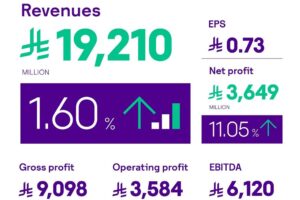by Gulraiz Khalid Khan
An overview of IntelligentRAN and how its supporting sustainable mobile networks based on exclusive interview with Calvin Zhao, Vice President of Huawei Wireless Network SingleOSS Product Line.
As one of the leaders in the telecom space, Huawei introduced its IntelligentRAN platform. Huawei’s new IntelligentRAN allows intelligent air interfaces to use key technologies such as smart grids, scheduling dictionaries, and channel graphs. With these capabilities, they can intelligently configure air interface resources and achieve optimal user experience and capacity. Service prediction with IntelligentRAN also guides non-real-time spectrum and channel selection on the network side and real-time symbol scheduling and transmit power configuration on the base station side. This significantly reduces energy consumption across the entire network. In addition, IntelligentRAN enables intelligent SLA site planning, where parameters are dynamically configured and models can be adjusted flexibly in response to service changes.
The IntelligenRAN platform is introduced at a time when network complexities are increasing continuously for some operators. Reflecting on this problem, Zhao said, “5G is now developing very quickly around the world, but this has brought a lot of challenges at the same time. For a lot of telecom operators, they now manage 2G, 3G and 4G plus 5G. So they are now managing four generations of technologies at the same time. It has exponentially increased the complexity of the network and that has inhibited the potential of the network.” The fact that a partial switch to 5G has only added more complexity to network management is true for all operators around the world.
As IntelligentRAN establishes itself as the gold standard for the industry, more and more operators are adopting strategies to become autonomous.
According to Zhao, IntelligentRAN not only enables operators to tackle the problems with multi channel network management but in fact, improves the management to higher standards. Zhao said, “With our IntelligentRAN solution, we use intelligent and collaborative coverage technologies for the optimal conditions with multi frequency and performance. We also combine the network forecasting of the traffic, so that we can achieve optimal multi-path judgment and decision-making.”
Such oversight enables the telcos to manage parameter settings much better allowing them to provide differentiated SLAs and also helps telcos manage the dynamic parameters to adapt to the service requirements with more custom made configurations for delivering optimal performance. This is very relevant to the mobile industry, now more than ever, as we enter the era of 5G with the new network supporting a myriad of industries through critical connectivity and driving the digital economy.
Talking about the improvements to the end-user experience, Zhao added, “The intelligent operation of the network is a very important factor that we consider when we design the solution. And I believe it’s also a very valuable aspect to implement the collaboration between network and base stations. We have several basic capabilities such as channel models, the scheduling dictionary and intelligent grids. With these basic capabilities we can provide the optimal performance based on heterogeneous networking with multiple frequency bands, multiple sites and multiple beams.”
Telecom operators and their partners strive to find ways to improve customer service on the same network. This is where IntelligentRAN makes the biggest difference.
These factors allow the optimization of the network according to network load and congestion. The unprecedented level of customization which IntelligentRAN provides means that network resources are fully utilized and optimized to be used where and when needed the most. This enables the operator to cater to a larger market whilst maintaining a high standard of delivery and actually improving the end-user experience which can now be configured according to the actual type of network usage.
Elaborating on Huawei’s approach in this respect, Zhao said, “We hope that IntelligentRAN solution can utilize intelligent algorithms to identify various scenarios and use the algorithm to find the optimal solution over iterations so that we can use one network to provide the optimal performance for different requirements from diverse service over different frequencies, to meet differentiated SLA requirements for different industries flexibily. Similar to ‘flexible manufacturing system’ in the manufacturing industry, that contains enough flexibility to allow the system to rapidly react to production changes. IntelligentRAN supports agile service rollout and accelerates the digital transformation of thousands of industries. Carriers can continuously generate revenue by continuously launching new services.”
In today’s world, where data and network usage is higher than ever before, service providers are often challenged by the competing price points for network services. The most common dilemma is to target network improvement and improvement on customer experience, all while maintaining competitive pricing. Revenue is directly linked towards high speeds that can allow customers to have a good experience, and it would be very accurate to say “Better customer experience = More Revenue”.
In such times, telecom operators and their partners strive to find ways to improve customer service on the same network. This is where IntelligentRAN makes the biggest difference. Zhao explained, “We can apply intelligent algorithms of machine learning or deep learning to help the self-learning of the network, through the application of intelligent technology such as Digital Twin, the physical network is digitally mapped to the digital twin network map, and a digital platform for simulation, verification, analysis and decision-making is built..” Such flexibility has now become the key to a sustainable network. With these capabilities, telecom operators’ O&M staff will no longer be buried by tiring, complicated and repetitive everyday tasks. Instead, they can focus on more value adding tasks, such as designing policies, developing the automated diagnosis capabilities and simulated network repair features and over iterations, they can develop a fault tree to provide better full cost of network faults.
With these capabilities, telecom operators’ O&M staff will no longer be buried by tiring, complicated and repetitive everyday tasks.
As IntelligentRAN establishes itself as the gold standard for the industry, more and more operators are adopting strategies to become autonomous. China Mobile is already on track for a level four autonomous network by 2025 and Vodafone has also proposed a Zero Touch Operation Network (ZTO) which is defined as an important part of their telco strategy.
Zhao concluded the discussion saying, “Intelligent network is an obvious direction of the future, and we are open to working with industry partners to collaborate and innovate together – to identify high value cases and cooperate extensively. Together, we aim to drive the development and large-scale application of the intelligent network, including our IntelligentRAN solution. In the end, we hope to boost the high quality development of the digital economy and to provide fundamental capabilities to support it.”












